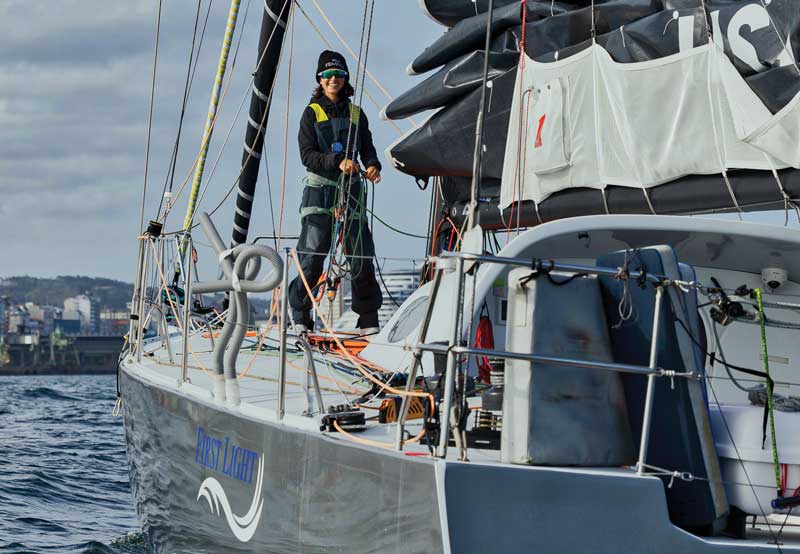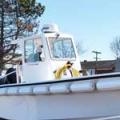Storm Recovery, Sailing Feats, Waterfront News
Storm recovery, short and long-term
Mainers will be dealing with the impact of last winter’s storms for a long time. In addition to cleaning up and repairing damaged waterfront structures including piers and fishing wharves, communities along the coast are having difficult conversations about planning for rising sea levels and damaging weather patterns, including new zoning rules and moving or abandoning roads that flood frequently.
But help is on the way. In late March, President Joe Biden approved a request by Maine Gov. Janet Mills to declare back-to-back January storms a major disaster. The move makes federal assistance available to Cumberland, Hancock, Knox, Lincoln, Sagadahoc, Waldo, Washington, and York counties.
Mills pegged the damage to public structures at $70.3 million, which did not include the damage to thousands of privately owned structures. A third storm in early March inflicted additional damage but was not part of the state’s request. This is the second disaster declaration for winter storms in Maine. More than $20 million in damages caused by a December wind and rain storm that hit inland areas especially hard was declared eligible for Federal Disaster Aid earlier in the year.
The March disaster declaration will make Mainers eligible for grants to cover the cost of temporary housing or home repairs, loans to cover uninsured property losses, and other recovery programs, according to a press release from the White House. Federal funding also will be available for state, tribal, and local governments and some nonprofits on a cost-sharing basis for emergency work and the repair or replacement of facilities damaged during the storms. Funds will also be available for “hazard mitigation.”
“With much of the marine and aquaculture field operating out of primary homes with private docks, hundreds of disaster survivors are now fighting to sustain generational family businesses with limited support. Maine produces 90 percent of the nation’s lobster supply and is home to a thriving marine economy now at risk of decline,” Mills wrote in her letter asking for help. “The recovery of Maine’s coastline will require the support of every federal resource available.”
In addition to the federal aid, a handful of nonprofits, including the Island Institute, have set up funds to help affected businesses. The governor has also proposed $50 million in state funds to help communities rebuild infrastructure and enhance climate resiliency, and included an additional $5 million in her supplemental budget to help another 100 cities, towns, and tribal governments create local plans to address vulnerabilities to extreme weather through the Community Resilience Partnership.
Meanwhile, in Washington, the Maine congressional delegation, including U.S. Sen. Susan Collins, announced that $15 million to help communities recover from coastal infrastructure damage is included in the 2024 appropriations bill, which has been signed into law. The legislation includes $10 million through the Atlantic States Marine Fisheries Commission to repair and renovate infrastructure affected by recent storms and $5 million to establish a new program for working waterfronts.
 Cole Brauer at work aboard First Light. ©Samuel Hodges Photography
Cole Brauer at work aboard First Light. ©Samuel Hodges Photography
Record-setting circumnavigation
Cole Brauer, who lived in and sailed out of Boothbay Harbor for several years, has made history as the first U.S. woman to sail solo, nonstop, around the world. The 29-year old sailed her Class 40 racing boat, First Light, into A Coruña, Spain, at 8:23 a.m. local time March 7, taking second place in the grueling Global Solo Challenge. Philippe Delamare finished February 24 to place first.
Fewer than 200 people have achieved a solo, nonstop circumnavigation since Sir Robin Knox-Johnston became the first man to do so in 1969. Kay Cottee was the first female to complete a solo circumnavigation in 1988. Brauer is the 18th female and first U.S. female to enter the history books for one of the toughest sporting endeavors there is. She took 130 days, 2 hours, 45 minutes, and 38 seconds, setting a new reference time for a solo circumnavigation on a 40-foot boat, improving by around seven days the previous record set in 2016, according to a press release from race organizers.
Brauer was one of 16 skippers competing in the race. She was both the youngest and the only female sailor in the fleet. Half the skippers who started the race were forced to drop out, including Shipyard Brewing-sponsored Ronnie Simpson, whose boat was dismasted off the Argentinian coast.
Brauer first started sailing in Boothbay Harbor. “My parents started coming to Boothbay Harbor when I was 6,” she told the Lincoln County News. After college she worked at Boothbay Harbor Yacht Club as a sailing instructor.
Brauer documented her experience on her Instagram account @colebraueroceanracing, racking up thousands of followers with her frank posts.
Wind power debates
The state has chosen Sears Island in Searsport as the staging ground for Maine’s new offshore wind project, a move supported by some environmental groups and opposed by others who have advocated for nearby Mack Point.
The decision involves about 100 acres of the 941-acre island, the East Coast’s largest undeveloped island. Maine Coast Heritage Trust holds a conservation easement on about 60 acres of the island, with the remainder reserved for transportation development under a deal negotiated in 2007.
Plans call for building components at the port for off-shore wind installations.
Opponents argue the port will damage the wildlife and hiking opportunities on the island, and note that Mack Point already has been developed with a working waterfront. The state contends that Sears Island is preferable because it already is owned by the state and will cost less to develop.
Meanwhile, in a related development, the federal agency regulating offshore wind installations has selected a 2 million-acre site offshore in the Gulf of Maine for floating offshore wind projects. The designated area, which at its closest point is 23 miles out, is 80 percent smaller than what originally was proposed, eliminating a lobster management area. Federal energy officials contend the new site avoids conflicts with lobster fishing and North Atlantic right whale habitat. But the Maine Lobstermen’s Association released a statement saying the organization remains opposed to all wind installations in the Gulf of Maine.
Sea Tow expands
Sea Tow Portland/Midcoast Maine has added a Sea Tow vessel in Kennebunk, which will operate from DiMillo’s Marina. Boasting the closest marina to downtown Kennebunk, DiMillo’s is located at 4 Doanes Wharf Road, just south of Dock Square on the Kennebunk River.
This is the second territory expansion of Sea Tow Portland/Midcoast since business owner Steve Arnold purchased the franchise in 2023. The move means a fleet of customized, fully equipped Sea Tow vessels will now be strategically positioned at marinas in Kennebunk, South Portland, Yarmouth, Naples, Sebago Lake, Bath, and Boothbay Harbor. Sea Tow’s captains maintain an average response time of under an hour.
Sea Tow captains regularly patrol and assist boaters in the coastal waters of Saco Bay, Portland Harbor, Casco Bay, Freeport, Brunswick, Harpswell, and the Boothbay region. In addition, they also cover the Saco, New Meadows, Kennebec, Sheepscot, and Damariscotta inland rivers, as well as freshwater areas including Sebago Lake, Long Lake, and Brandy Pond.
With a Sea Tow membership, boaters pay one annual rate and receive member benefits available 24/7 year round. Arnold owns Marina Holdings LLC. The company’s portfolio includes Sea Tow Portland/Midcoast, Yarmouth Boat Yard, Moose Landing Marina, Freedom Boat Club of Maine, Maine Boating Academy, and Portland Sea Taxi by Sea Tow, an on-water taxi service in Portland Harbor and throughout the islands of Casco Bay.
The news came at the same time that the Freedom Boat Club announced its seventh Maine location in Kennebunk, also at DiMillo’s Marina. Freedom Boat Club lets members share boats, which in Maine include 22- to 25-foot center consoles, dual consoles, cruisers, rigid inflatables, and pontoon boats.
New training ship means new dock
Maine Maritime Academy will have a new, purpose-built training ship for its cadets when the vessel arrives in Castine, which is scheduled for spring of 2025.
The new ship won’t just mean improved training for MMA students. It also will mean changes for the local harbor and for mariners who come and go from the town’s waterfront, according to a report in the Bangor Daily News.
The new $320 million vessel will be about 24 feet longer and 16 feet wider than the academy’s existing ship, which means redoing the academy’s waterfront pier. In addition to accommodating the larger vessel, the pier must be rebuilt to handle sea level rise.
The new pier is expected to extend into the harbor 135 feet farther from shore than the current pier, according to the report. This will change the approach to the town pier.
Castine Harbormaster Steve Vogell told the newspaper that the town plans to extend one of its piers farther out to help shorten the distance around the docked ship, to weaken the influence of the outgoing tide, and to make the town facilities more resilient to sea level rise.
PFAs in the water
Scientists working with Casco Baykeepers and Bigelow Laboratory for Ocean Sciences collected more than 100 per- and polyfluoroalkyl substances samples at 18 sites in Casco Bay in 2023, hoping to understand the extent to which the forever chemicals have seeped into the ocean. They found widespread—but not alarming—levels of several of these chemicals across the region, highlighting the need for more research into the sources of PFAS and their possible impacts on the marine environment, according to a release from the Baykeepers.
PFAS were detected at all of the study’s monitoring sites. There is no safety standard for PFAS in marine waters, but all levels were below current state drinking water regulations, according to the release. The levels appeared to dilute as offshore measurements were lower than those closer to shore.
The test results mark the first step of a multi-year, collaborative project to understand the sources of these toxic chemicals and measure their impacts to the coastal environment.
Good and bad news for the fisheries
Maine’s seafood industry proved its value in 2023, with landings worth more than $611 million, a $25 million increase over the previous year, according to preliminary data released by the Maine Department of Marine Resources.
The jump in overall value can largely be attributed to a strong boat price for lobster, Maine’s most valuable species in 2023. The price per pound paid to fishermen increased from $3.97 in 2022 to $4.95 per pound in 2023. The price increase offset a decline in overall lobster landings, which fell to 94 million pounds, the smallest catch in 15 years.
Maine’s elver fishery once again was the second most valuable in 2023, earning fishermen $19.5 million on the strength of a $2,009 per pound price. Softshell clam diggers earned $13.9 million, which made the fishery the state’s third most valuable. Maine oysters were the fourth most valuable harvested product at over $11 million on the strength of a 20-cent per pound increase in value. Menhaden, used as lobster bait, was the state’s fifth most valuable.
Maine’s groundfish industry also saw an increase in landings and a more stable price due in part to investments DMR made in the Portland Fish Exchange, Vessel Services, and the Maine Coast Fishermen’s Association with Covid relief funds from NOAA, according to the DMR release.
The downward trend in lobster landings coincides with reports of declines in the juvenile lobster population along the coast, which has prompted fisheries regulators to propose increasing the minimum legal size for lobsters, beginning in January 2025. That, fears about the impact of offshore wind turbines on the lobster fishery, and the prospect of new rules to protect endangered right whales were major topics of discussion at the Maine Fishermen’s Forum in March.
While federal fisheries scientists have blamed the death of a right whale off the Massachusetts coast this spring on entanglement in Maine lobster gear, Maine fisheries regulators told conference attendees that they need more information before agreeing with that finding.
In the meantime, DMR Commissioner Patrick Kelleher announced at the forum a slew of new initiatives to track right whales in Maine waters in an effort to better understand the extent to which the endangered cetaceans are threatened by Maine lobster gear.
Help for a Maine icon
The Moosehead Marine Museum will receive $500,000 as part of the FY2024 federal appropriations bill. The funds will go toward MMM’s “Keep Kate Cruising” a campaign to restore the 109-year-old historic steamship, Katahdin. The museum’s executive director, Liz McKeil, said the Katahdin annually draws 8,500 visitors to the region to cruise Moosehead Lake and to visit the shoreside museum that houses more than 2,000 artifacts, photographs and items of memorabilia from the lake’s past when steamboats like the Katahdin plied the waters. With this funding, the campaign has raised 78 percent of the final goal of $2 million. The Shipyard at Boothbay Harbor, which is part of Bristol Marine, already has completed some restoration work on the historic vessel, which is being done in phases. Restoration of the upper aft fantail deck was completed in early June 2023. Work on the upper port deck started in October and will be completed before the 2024 cruising season. The next phase will involve replacement of the green rail and side decking.
Cruise ship cap
A federal judge has upheld a cap on cruise ship visits that Bar Harbor voters approved in November 2022. The restrictions limiting cruise ship passenger visits to 1,000 passengers per day were adopted after town officials were pressured to reduce the impact that cruise ships have on the town during the busy summer and fall tourist seasons. A group of local businesses had filed a suit challenging the restrictions, arguing that they violated federal maritime law, and in addition, that they would hurt local businesses.
The debate over cruise ships has been simmering for a few years in a number of coastal towns.
Some residents and business owners argue that visits by the big ships provide a crucial economic benefit, others complain that the cruises bring overcrowding and that the ships pollute.
Over the bar
The Maine coast lost a friend this spring with the death of philanthropist and businesswoman Linda Bean. She was a conservationist, a patron of the arts (particularly the Wyeths), and of the air ambulance service LifeFlight. She owned quite a bit of Maine real estate, and was in the process of supervising the reconstruction of the Port Clyde General Store, which had burned last year. She will be missed.
✮
Related Articles
Share this article:
2023 Maine Boat & Home Show

Join Us for the Maine Boat & Home Show!
Art, Artisans, Food, Fun & Boats, Boats, Boats
August 11 - 13, 2023 | On the waterfront, Rockland, Maine
Click here to pre-order your tickets.
Show is produced by Maine Boats, Homes & Harbors magazine.















